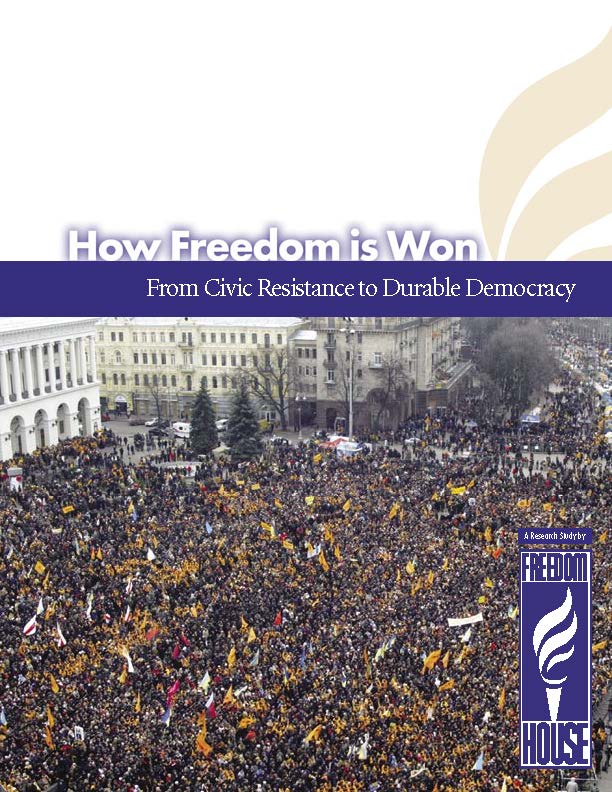ICNC-Funded Research and Academic Writing
Below is a list of ongoing and completed research projects that ICNC has funded in whole or in part, together with the links to their corresponding publications through the ICNC Press.
ICNC also provides advice and/or offers feedback on the supported research when requested by the researcher or stipulated by the contractual arrangement with the researcher(s).
To learn more about ICNC’s academic programs click here.

Ongoing Research
Quantifying Anti-Coup Civil Resistance
Abstract: How often does primarily nonviolent “anti-coup” civil resistance arise to challenge coups d’état (illegal seizures of power by armed forces or regime insiders)? How does mass mobilization affect the outcome of coups? How often is civil resistance effective in rapidly defeating coups without bloodshed within a week? Does nonviolent anti-coup protest increase the likelihood that “endgame coups”, those that occur due to security force defections amidst mass uprisings, rapidly promote democratization?
These are the questions that this research aims to address while it develops a new cross-national data (the Colpus Mass Mobilization dataset) on coups d’état and civil resistance covering the entire population of over 540 coup attempts from 1946 to 2019. The research focus will be on the efficacy of post-coup civil resistance and short-term anti-coup resistance.

Role and Impact of Uncertainty on Dissent
Abstract: The research project analyzes the effect of uncertainty on dissent – uncertainty as to what behaviors regimes are willing to permit and the severity of the punishment for behaviors that they are not. The starting assumption is that uncertainty reduces the likelihood of dissent. Although it does so to a lesser degree than certainty, it has a more pernicious effect on dissent because it results in individuals not engaging in acts of dissent that governments are potentially willing to tolerate. The project examines the various channels through which (un)certainty may affect dissent, including expectations regarding others’ likelihood to dissent and the likelihood and severity of the punishment for dissent, as well as emotions, such as anger, fear, anxiety, stress, powerlessness. The project also analyzes the extent to which uncertainty varies across contexts and characteristics of individuals.

Completed & Published Research: 2020-2024
All Rise: Judicial Resistance in Poland
Available for purchase here.
This monograph investigates the strategic and organized resistance of Polish judges against the authoritarian encroachments on judicial independence by the ruling Law and Justice (PiS) party from 2015 to 2023. Under the leadership of Jarosław Kaczyński, PiS systematically targeted key judicial institutions like the Constitutional Tribunal and the Supreme Court, implementing reforms to undermine judicial autonomy. This assault sparked an unprecedented resistance movement among Polish judges, who employed legal and extralegal tactics to defend the rule of law.
The resistance movement led to significant national and international outcomes, including presidential vetoes of controversial judicial reform bills, the reinstatement of judges, and actions by the Court of Justice of the European Union (CJEU) and the European Court of Human Rights (ECHR) against Poland. These efforts not only emphasized the importance of judicial independence as a cornerstone of democracy but also provided a powerful example for other nations facing similar authoritarian threats.
Through interviews with key judicial and legal figures, the monograph offers a comprehensive account of the motivations, actions, and consequences of judicial resistance in Poland. Furthermore, it catalogs the judges’ many actions according to Michael Beer’s framework of tactics from Civil Resistance Tactics in the 21st Century. Herein are valuable insights into the role of the judiciary in defending democracy, with broader implications for prodemocracy movements worldwide.
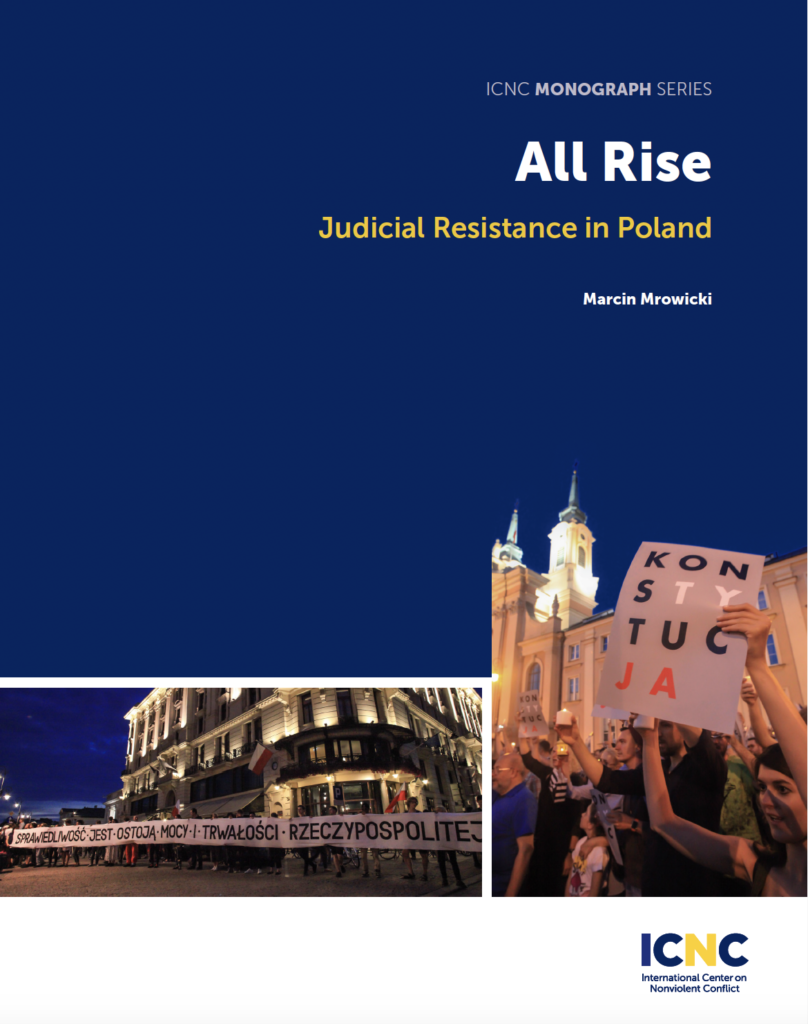
Prison Hunger Strikes in Palestine: A Strategic Perspective
ICNC Monograph
This publication is the first major transnational examination of prison hunger strikes. While focusing on Palestine, the research is enriched by extensive interviews and conversations with South African, Kurdish, Irish, and British ex-prisoners and hunger strikers. This study reveals in unprecedented detail how prison hunger strikes achieve monumental feats of resistance through the weaponization of lives.
How do prison hunger strikers achieve demands? How do they stay connected with the outside world in a space that is designed to cut them off from that world? And why would a prisoner put their lives at risk by refusing to eat or, at times, drink? This research shows that sometimes prisoners’ need for dignity (karamah) and freedom (hurriya) trump their hunger pangs and thirst.
Prison Hunger Strikes in Palestine evaluates the process of hunger striking, including the repressive actions prisoners encounter, and the negotiation process. It analyzes differences and similarities between individual and collective strikes, and evaluates the role and impact of solidarity actions from outside the prison walls.
The work’s critical and grassroots understanding of prison hunger strikes fully centers the voices of hunger strikers. The analysis results in actionable takeaways that will be as useful to prison activists as they will be to their allies around the world.

Dollars and Dissent: Donor Support for Grassroots Organizing and Nonviolent Movements
ICNC Special Report Series
Around the world, more people than ever before are using nonviolent collective action to secure rights, achieve justice, and build democracy. This strategy has been twice as effective at attaining these goals than has violent action. Yet despite this, from 2011 to 2018, public charities and private foundations gave only three percent of their total human rights funding to support nonviolent collective action.
Drawing on in-depth interviews and surveys with donors and grantees, this report outlines trends in donor support and details how donors’ values, organizational structures, and perceptions of risk affect their support for the work of grassroots organizers and nonviolent social movements. Furthermore, this report assists donors seeking to deepen their understanding of whether, when, where, and how to provide this support.

Resource Mobilization in Palestinian Nonviolent Campaigns
ICNC Monograph Series
Abstract: This monograph analyzes how Palestinian grassroots activists, popular resistance committees (PRCs), and popular resistance networks (PRNs) secured, managed, and used material and non-material resources to wage sustained and successful nonviolent campaigns in Area C of the occupied West Bank.
A comprehensive analytical framework is developed to capture a variety of resources and to better understand the role that different types of resources have in the launching, conducting, and outcomes of a campaign. This framework is then used to analyze three nonviolent campaigns led by Palestinian communities living under occupation, highlighting how the Palestinian activists managed to secure, administer, and deploy a diverse range of material and non-material resources to support their campaigns.
This study offers specific recommendations and lessons learned from the investigated cases for various actors—including activists, allies that want to support grassroots campaigns, and researchers interested in furthering the study of the role and impact of resources in nonviolent organizing and their successful acquisition by local organizers.

The Pashtun Protection Movement (PTM) in Pakistan
ICNC Special Report Series
Free Download: English | Urdu
Purchase a Print Copy
Purchase an e-book (Nook | Kindle)
Abstract: The Pashtun Protection Movement Pakistan (PTMP) is a youth-led nonviolent resistance campaign for human rights for the Pashtun people in northwestern Pakistan. This movement’s is reminiscent of Pashtun historical icon Bacha Khan’s organizing nonviolent action for justice in Pakistan’s past. How are these young Pashtuns differentiating themselves from violent religious extremists (e.g. Taliban Movement) and resisting government repression and mistreatment through nonviolent resistance activities? How do they develop and use nonviolent strategies and tactics in their protests and actions? How do they engage supporters and opponents of the movement? How do they manage funding and media coverage of their activities? The study seeks to answer these and other questions questions via relevant field research and data collection and is funded by the ICNC as part of its 2018 rapid field data collection grant.

Civil Resistance Against Climate Change
ICNC Monograph Series
Free Download
Purchase a Print Copy
Purchase an e-book (Nook | Kindle)
Abstract: Transnational movements using nonviolent resistance tactics to demand action on climate change have emerged from a foundation of decades of persistent and diverse environmental activism. What are the features of this nonviolent resistance that differentiate it from previous activism? What response is this resistance prompting from political and financial entities? To investigate these questions this monograph combines a large-scale longitudinal data set on climate activism in Australia with two case studies of nonviolent resistance against corporations. Through this analysis the monograph will create an extensive empirical data set for theory-testing about climate change activism, as well as a tool to help practitioners engaged in climate activism make timely and well-informed strategic and tactical decisions.

The Impact of Nonviolent Resistance on the Peaceful Transformation of Civil War
ICNC Monograph Series
Free Download
Purchase a Print Copy
Purchase an e-book (Nook | Kindle)
Abstract: In recent years, a burgeoning literature has explored the strategic advantages of using nonviolent resistance to achieve positive political outcomes, such as regime change and democratization. Yet, despite one-fifth of large-scale nonviolent campaigns occurring during the course of a civil war, we know little about the affect nonviolent resistance might have on the transformation of armed conflict. Bringing together the previously isolated literatures on nonviolent resistance and peacebuilding, this manuscript explores how nonviolent resistance can aid peacebuilding efforts that transform ongoing armed conflict, using data on all civil wars episodes since 1945. The finding show nonviolent resistance does have a positive impact on the resolution of armed conflict, with evidence deriving from a Large-N statistical analysis, out-of-sample prediction and structured-focused case studies.

How Social Trust Shapes Civil Resistance: Lessons from Africa
ICNC Monograph Series
Free Download
Purchase a Print Copy
Purchase an e-book (Nook | Kindle)
Abstract: What role does trust play in shaping the outcomes of civil resistance campaigns? Trust has been found to be a critical factor in building political and social capital, encouraging group cohesion, and overcoming collective action problems. Despite this, trust has not been directly addressed by the civil resistance scholarship. This monograph addresses this lacuna by examining how trust shapes – and is shaped by – three levels of mobilization: trust at the individual level, trust within activist groups, and trust across resistance campaigns.

Nonviolent Movements and Material Resources in Northwest Mexico
Free Download
Purchase a Print Copy
Purchase an e-book (Nook | Kindle)
Nonviolent resistance movements operate with few resources and nearly no money. Yet these movements thrive and often succeed. The little external funding for civil society that is available rarely reaches the grassroots groups that are the backbone of these movements. How do they get the material resources they need? This study highlights strategies that are being used effectively by nonviolent movements to mobilize the resources they need to galvanize participation in movement actions and influence both the public and policymakers. Based on the experience of three campaigns in Northwest Mexico over two decades, the research finds that material resources are often mobilized internally in a decentralized way, driven by effective strategic planning and actions. We discuss the strategic choices nonviolent movements make to mobilize resources and how they direct them as situations change, and how outside supporters can provide resources in a constructive way.
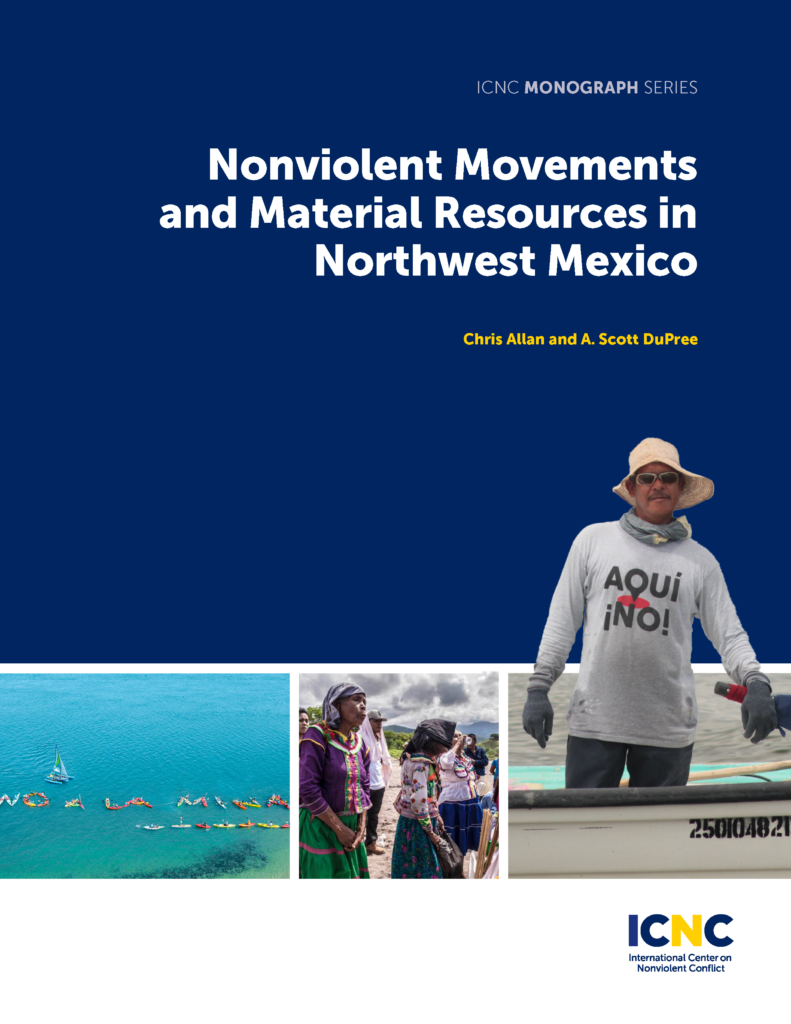
The Role of External Support in Nonviolent Campaigns: Poisoned Chalice or Holy Grail?
Free Download
Purchase a Copy
Purchase an e-book (Nook | Kindle)
Abstract: This monograph draws from an ICNC-sponsored multi-year research project that examines the effects of different forms of external aid on the outcomes and longer-term impacts of civil resistance campaigns. Very little research has systematically investigated the impacts of external support on the effectiveness of nonviolent resistance. Existing research reaches somewhat contradictory conclusions, with some finding that external support for nonviolent campaigns is harmful, that external support is sometimes helpful, or that external support has little observable effect. This study will assess different types of external – material and non-material – assistance to civil resistance movements offered by state ad non-state actors at different stages of civil resistance: pre, during and post-conflict periods. Finally, it will evaluate the impact of the specific type of aid, its timing and provisions by different actors on the overall trajectories of civil resistance campaigns and their outcomes.

Civil Resistance Tactics in the 21st Century
ICNC Monograph Series
Free Download: English | Farsi | Spanish
Purchase a Print Copy
Purchase an e-book (Nook | Kindle)
Abstract: Revisiting the tactics of nonviolent resistance adds new methods of nonviolent action to the list of 198 methods categorized by Gene Sharp in 1973 in his book, The Methods of Nonviolent Action. This monograph inspires readers that nonviolent action encompasses a big category of human activity and that new and old tactics are employed daily. It also analyzes strengths and weaknesses of Dr. Sharp’s typologies and updates his work by documenting additional methods of nonviolent action and new scholarship from the fields of civil resistance, human rights defense, and social change. The monograph surveys the work of scholars and activists who have contributed alternative nonviolent typologies. Methods documented by other scholars are gathered, organized and added to Dr. Sharp’s list of methods. The monograph also documents undiscovered methods and proposes helpful new categories of nonviolent action. The monograph concludes with a summary of lessons learned and how they are relevant for practitioners, educators, and scholars of civil resistance. Recommendations are made for further application and research.

How to Win Well: Civil Resistance Breakthroughs and the Path to Democracy
Free Download
Purchase a Print Copy
Purchase an e-book (Nook | Kindle)
Abstract: How do nonviolent resistance movements oust dictators? What effects do these different ways of ousting dictators have on countries’ long-term political trajectories? In this special report, I trace the pathways through which civil resistance movements of the last seventy years have removed dictatorships and the impact of these different pathways on levels of democratic progress. I find that pathways that involve campaign initiative, institutional mechanisms, and building cooperative norms – particularly negotiated transitions – tend to lead to the highest levels of democratic progress.
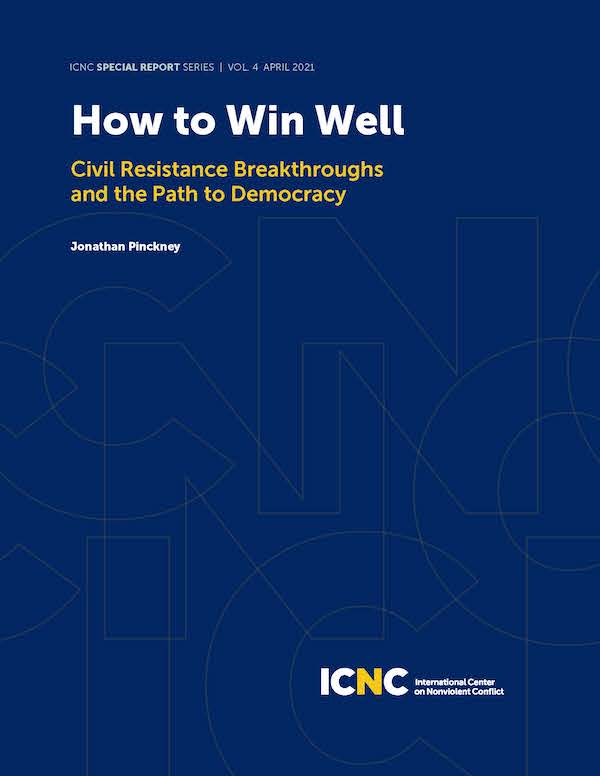
Sudan’s 2019 Revolution: The Power of Civil Resistance
Free Download
Purchase a Print Copy
Purchase an e-book (Nook | Kindle)
The Sudanese revolution began in December 2018 with a series of strikes, protests, and other acts of civil resistance taking place throughout the country. In February 2019, dictatorial president Omar al-Bashir declared a state of emergency and dissolved the national and regional governments, strengthening direct rule by military and intelligence officers. Massive protests resumed in early April and the military staged a coup, removing al-Bashir from power after a 30-year rule and assuming power as the Transitional Military Council. Pro-democracy activists demanded they turn over power to a civilian-led interim government with protests, along with negotiations, continued. On June 3, security forces massacred 128 people and detained and abused hundreds of detainees. Pro-democracy groups responded with a general strike and increased protests. Negotiations resumed and an agreement was signed in August formally transferring the government to civilian-led bodies.
This study interviews key activists in the movement as well as journalists and scholars who chronicled it and key civil society groups which led the struggle. This qualitative research takes place primarily in Khartoum and Omdurman, the country’s two largest cities.

From the Hills to the Streets to the Table: Civil Resistance and Peacebuilding in Nepal
Free Download
Purchase a Print Copy
Purchase an e-book (Nook | Kindle)
This case study builds on Véronique Dudouet’s 2017 ICNC Special Report, Powering to Peace: Integrated Civil Resistance and Peacebuilding Strategies. Utilizing Dudouet’s framework, we trace the development of conflict in Nepal over the past thirty years, with a specific emphasis on the 2006 civil resistance campaign and subsequent peace process that led to the resolution of the country’s decade-long Maoist insurgency.
What were the drivers of social and political conflict in Nepal that led to the 2006 civil resistance campaign? How were the Maoists convinced to transition from armed insurgency to civil resistance? What accounts for the success and failures of the subsequent peace process? Leveraging the Dudouet framework, we trace the trajectory of conflict from a period of latent conflict with high levels of horizontal inequalities and structural violence to an outbreak of overt, but initially violent conflict. We then illustrate how a transition from civil war to civil resistance was made possible and led to a successful conflict settlement. However, flaws in the conflict settlement and post-conflict phases have produced a turbulent post-settlement process, one that falls short of the goals of reconciliation, transitional justice, and sustainable peace.

Working Tirelessly for Peace and Equality: Civil Resistance and Peacebuilding in Liberia
ICNC Special Report Series
Date of Publication: May 2021
Free Download
Purchase a Print Copy
Purchase an e-book (Nook | Kindle)
From the establishment of the Liberian state in 1848, the Americo-Liberian settlers—descendants of freed slaves from the USA—imposed a form of indirect rule over the indigenous Liberian population that oppressed, marginalized and exploited the majority of the population. This treatment of the native population became increasingly unsustainable, and in 1980 the settler government was overthrown. A 10-year dictatorship was followed by a violent civil war that lasted until 2003. Using the framework developed by Veronique Dudouet in her 2017 ICNC Special Report, Powering to Peace: Integrating Civil Resistance and Peacebuilding Strategies, this case study examines the methodologies and approaches of the various actors involved in civil resistance and peacebuilding throughout the various phases of conflict in Liberia, from a period of latent conflict to the post-settlement phase after 2003. Many different actors in Liberia pursued strategies of peacebuilding and civil resistance simultaneously, which led to the complementarity of their work and increased the impact they had on both political and civic reform, as well as on the ultimate peace process. The case study takes an in-depth look at the impact that the strategies had on each other in their common pursuit of peace and justice in Liberia.

Completed & Published Research: 2015-2019
External Support for Nonviolent Campaigns: Data Collection and Analysis
Abstract: ICNC supported a research team led by Erica Chenoweth and Maria J. Stephan to examine the effects of different forms of external aid—or combined forms of external aid—on the outcomes and longer-term impacts of civil resistance campaigns. Researchers collected and analyzed systematic data on numerous nonviolent campaigns to assess their impacts. The key research findings on the role and impact of external support to nonviolent movements will be published in authors’ forthcoming ICNC monograph (2020).

Preventing Mass Atrocities: From a Responsibility to Protect (RtoP) to a Right to Assist (RtoA) Campaigns of Civil Resistance
ICNC Special Report Series
Free Download: English | Arabic | French | Spanish | Purchase a Print Copy
Purchase an e-book (Nook | Kindle)
Events of the last decade demand new approaches to atrocity prevention that are adaptable, innovative and independent of a state-centered doctrine. With the aim of reducing risk factors such as civil war, we argue for a new normative framework called The Right to Assist (RtoA), which could strengthen international coordination and support for nonviolent civil resistance campaigns demanding rights, freedom and justice against non-democratic rule.
RtoA would: 1) engage a wide range of stakeholders such as NGOs, states, multilateral institutions and others; 2) bolster various factors of resilience against state fragility; and 3) incentivize opposition groups to sustain commitment to nonviolent strategies of change. The adoption of this doctrine can reduce the probability of violent conflict that significantly heightens atrocity risk, while increasing the prospects for constructive human development.

When Civil Resistance Succeeds: Building Democracy After Popular Nonviolent Uprisings
ICNC Monograph
Free Download
Purchase a Print Copy
Purchase an e-book (Nook | Kindle)
Abstract: Why do many nonviolent revolutions lead to successful democratization while some fail to consolidate democracy? And what can activists do to push toward a victory over dictatorship that results in long-term political freedom? Studies have shown that nonviolent revolutions are generally a more positive force for democratization than violent revolutions and top-down political transitions. However, many nonviolent revolutions, such as the Arab Spring revolution in Egypt, do not seem to support this argument. Taking on this puzzle, the present study reveals that the answer lies in in large part in the nonviolent actions of the civil society prior and during transition. In particular, it is linked to the ability of activists to keep their social bases mobilized for positive political change while directing that mobilization toward building new political institutions.
The monograph first lays out the current state of scholarly knowledge on the connections between nonviolent resistance and democratization. It then presents new statistical evidence that nonviolent resistance has a positive effect on democratization independently of other conditions. Additionally, an-in-depth case studies of Nepal, Zambia and Brazil demonstrate that the positive effect of civil resistance on democratic transition requires continued civic mobilization and a move away from radical, all-or-nothing struggles toward more regular, institutionalized politics. The study concludes with concrete takeaways on ways to achieve these changes, designed for civil resistance thinkers, activists and external actors interested in supporting nonviolent movements.

The Role of Civil Resistance in Bolivia’s 1977-1982 Pro-Democracy Struggle
2018
Abstract: Despite being the poorest and least developed country in South America, Bolivia was the first to emerge from the period of military dictatorships that dominated the continent from the mid-1960s into the 1980s. This article examines the role of civil resistance in that country’s seemingly improbable early end to military rule, noting how a broad coalition of unions, intellectuals, the Catholic Church, and opposition parties succeeded in bringing down a series of military leaders, eventually ushering in elected civilian governance. Despite the pro-democracy movement’s successful defeat of the dictatorship of Hugo Banzer in 1978, it took more than four years, three general elections, five presidents and several coups d’état before full electoral democracy was restored. This article responds to questions of how the movement was able to persist, grow, and maintain largely nonviolent discipline in the face of severe repression, shifting alliances, and internal divisions, and how the movement helped lay the groundwork for more recent radical changes in Bolivian politics. The article illustrates other critical factors in the movement’s success: the willingness to avoid armed struggle, the country’s rich tradition of mass-based civil resistance and defiance of central authority, and grassroots democratic relations.
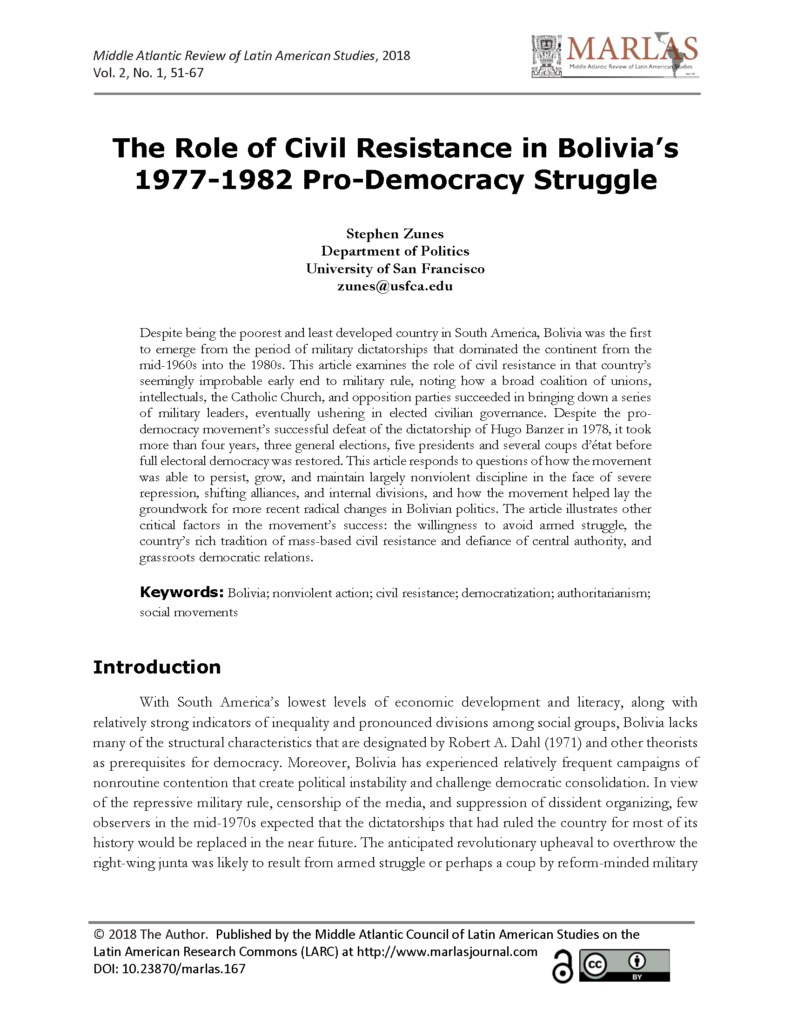
Nonviolent Resistance and Prevention of Mass Killings During Popular Uprisings
April 2018
Free Download
Purchase a Print Copy
Purchase an e-book (Nook | Kindle)
Abstract: What drives governments to crack down on and kill their own civilians? And how—and to what extent—has nonviolent resistance historically mitigated the likelihood of mass killings? This special report explores the factors associated with mass killings: when governments intentionally kill 1,000 or more civilian noncombatants. We find that these events are surprisingly common, occurring in just under half of all maximalist popular uprisings against states, yet they are strongly associated with certain types of resistance. Nonviolent uprisings that do not receive foreign material aid and that manage to gain military defections tend to be the safest. These findings shed light on how both dissidents and their foreign allies can work together to reduce the likelihood of violent confrontations.

Civil Resistance against Coups: A Comparative and Historical Perspective
ICNC Monograph
December 2017
Free Download: English | Thai
Purchase a Print Copy
Purchase an e-book (Nook | Kindle)
Abstract: Nations are not helpless if the military decides to stage a coup. On dozens of occasions in recent decades, even in the face of intimidated political leaders and international indifference, civil society has risen up to challenge putschists through large-scale nonviolent direct action and noncooperation. How can an unarmed citizenry mobilize so quickly and defeat a powerful military committed to seizing control of the government? What accounts for the success or failure of nonviolent resistance movements to reverse coups and consolidate democratic gains?
This monograph presents in-depth case studies and analysis intended to improve our understanding of the strategic utility of civil resistance against military takeovers; the nature of civil resistance mobilization against coups; and the role of civil resistance against coups in countries’ subsequent democratization efforts (or failure thereof). It offers key lessons for pro-democracy activists and societies vulnerable to military usurpation of power; national civilian and military bureaucracies; external state and non-state agencies supportive of democracy; and future scholarship on this subject.
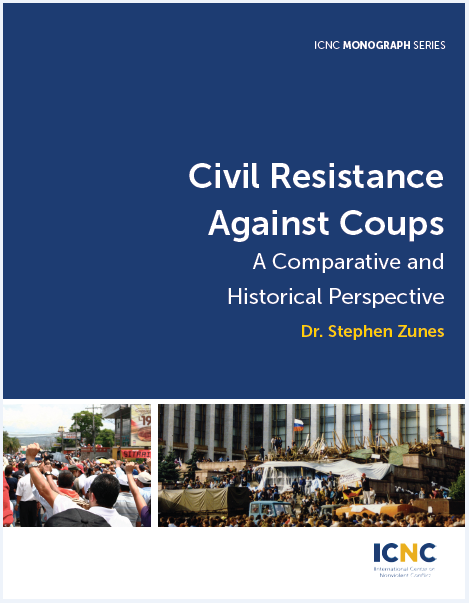
Powering to Peace: Integrated Civil Resistance and Peacebuilding
Free Download: English | French
Purchase a Print Copy: English | French
Purchase an e-book (Nook | Kindle)
Abstract: This monograph will offer a conceptual and empirical review of the civil resistance–peacebuilding nexus. It will explore the analytical definitions, boundaries and distinctions between these two approaches to conflict transformation, as well as their multiple areas of (potential or actual) complementarity. It will do so through a systematic coverage of the relevant scholarship as well as a succinct analysis of relevant case studies, where peacebuilding activities have accompanied, preceded or followed civil resistance campaigns. A number of concrete lessons learnt will also be identified and targeted to relevant audiences: (1) conceptual implications and areas for further research, (2) recommendations for nonviolent activists and peacebuilding practitioners, and (3) policy lessons learnt for international actors (bilateral donors, diplomats and inter-governmental agencies) seeking to support constructive and effective conflict transformation processes.
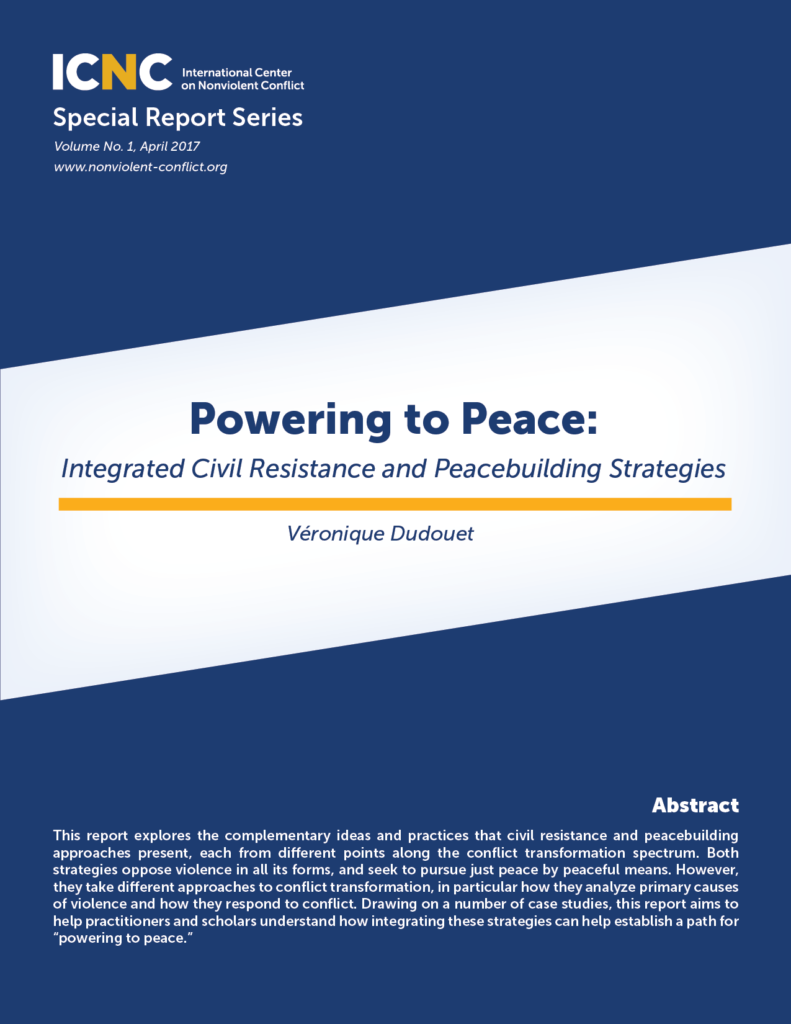
People Power Movements and International Human Rights: Creating a Legal Framework
ICNC MonographAugust 2017
Revised July 2019
Free Download
Purchase a Print Copy
Purchase an e-book (Nook | Kindle)
Abstract: International human rights law did not come into existence top-down, out of the benevolent intentions of states, even though states eventually began to recognize that large-scale human rights abuses could pose a threat to the international order. Rather, it came into existence from the bottom-up efforts of ordinary people in civil society to ally with each other in solidarity and demand their rights, often through organized nonviolent campaigns and movements that pressured elites and powerholders to recognize or grant individual rights (freedom for slaves, women’s rights, labor rights, and children’s rights, to name a few). Unlike international law generally, the real source of international human rights law has been the coordinated, organized and nonviolently forceful efforts of individuals—in other words, what one can refer to as people power.

Nonviolent and Violent Campaigns and Outcomes (NAVCO) Data Project
Abstract: The Nonviolent and Violent Campaigns and Outcomes (NAVCO) Data Project is a multi-level data collection effort funded by ICNC that now includes: NAVCO v. 1.0; NAVCO 1.1; NAVCO 2.0, and NAVCO 3.0. Principal Investigators of the NAVCO data project are: Erica Chenoweth (all versions), Orion Lewis (NAVCO 2.0 and 3.0) and Jonathan Pinckney (NAVCO 3.0).
NAVCO dataset catalogues major nonviolent and violent resistance campaigns around the globe from 1900-2011. Researchers can use these data to better answer questions about how tactical choices lead to the success or failure of such political movements, how inter-group relationships among competing insurgent organizations affects their strategic choices, and how the sequencing of tactical choices influence the overall outcomes of resistance campaigns.
The project produces aggregate-level data on resistance campaigns from 1900-2006 (NAVCO 1.1), annual data on campaign behavior from 1945-2006 (NAVCO 2.0) and events data on tactical selection during campaigns from 1987-2011 (NAVCO 3.0). NAVCO 2.0 will be regularly updated with new cases of civil resistance struggles.
The NAVCO project led to the publication of the book by Erica Chenoweth and Maria Stephan titled Why Civil Resistance Works, published by Columbia University Press in 2011.
The NAVCO project also led to the publication of the following related articles in the academic journals:
• Days of Rage: Introducing the NAVCO 3.0 Dataset
Authors: Erica Chenoweth, Jonathan Pinckney, and Orion Lewis, Journal of Peace Research, 2018, Vol. 55, No. 4, 524–534
• Unpacking Nonviolent Campaigns: Introducing the NAVCO 2.0 Dataset Authors: Erica Chenoweth and Orion A. Lewis, Journal of Peace Research, 2013, Vol. 50, No. 3, 415-423
• Why Civil Resistance Works: The Strategic Logic of Nonviolent Conflict
Authors: Erica Chenoweth and Maria J. Stephan, International Security, Summer 2008, Vol. 33, No. 1, pp. 7–44

Making or Breaking Nonviolent Discipline in Civil Resistance Struggles
ICNC Monograph
2016
Free Download: English | Chinese | Summary of findings in Farsi
Purchase a Print Copy
Purchase an e-book (Nook | Kindle)
Abstract: How can we understand when nonviolent movements will stay nonviolent? When are they likely to break down into violence? In this monograph, Jonathan Pinckney analyzes both what promotes and undermines nonviolent discipline in civil resistance movements. Combining quantitative research on thousands of nonviolent and violent actions with a detailed comparison of three relevant case studies of civil resistance during the “Color Revolutions”, Pinckney’s analysis provides important lessons for activists and organizers on the front lines, as well as for practitioners whose work may impact the outcomes of nonviolent struggles. We learn how repression consistently induces violence, as do government concessions. On the flip side, we see that structuring a campaign in an inclusive and non-hierarchical way is conducive to greater nonviolent discipline.

Civil Resistance in the Arab Spring: Triumphs and Disasters, 1st Edition
Oxford University Press
2016
Purchase a Print Copy: English | Arabic
Purchase an e-book (Kindle)
Abstract: Civil resistance, especially in the form of massive peaceful demonstrations, was at the heart of the Arab Spring-the chain of events in the Middle East and North Africa that erupted in December 2010. It won some notable victories: popular movements helped to bring about the fall of authoritarian governments in Tunisia, Egypt, Libya and Yemen. Yet these apparent triumphs of nonviolent action were followed by disasters — wars in Syria, anarchy in Libya and Yemen, reversion to authoritarian rule in Egypt, and counter-revolution backed by external intervention in Bahrain. Looming over these events was the enduring divide between the Sunni and Shi’a branches of Islam. In this book, experts on these countries, and on the techniques of civil resistance, set the events in their historical, social and political contexts. They describe how governments and outside powers — including the US and EU — responded, how Arab monarchies in Jordan and Morocco undertook to introduce reforms to avert revolution, and why the Arab Spring failed to spark a Palestinian one. They indicate how and why Tunisia remained, precariously, the country that experienced the most political change for the lowest cost in bloodshed.

Civil Resistance and Conflict Transformation
Routledge Studies in Peace and Conflict Resolution
2015
Purchase a Print Copy
Purchase an e-book (Nook | Kindle)
Abstract: This book investigates the decision-making process, rationale and determining factors which underlie the strategic shifts of armed movements from violent to nonviolent resistance. The revival of global interest in the phenomenon of nonviolent struggle since the 2011 Arab Spring offers a welcome opportunity to revisit the potential of unarmed resistance as an alternative pathway out of armed conflicts, in cases where neither military (or counter-insurgency) nor negotiated solutions have succeeded. This volume brings together academics from various disciplinary traditions and offers a wide range of case studies – including South Africa, Palestine and Egypt – through which to view the changes from violence to nonviolence within self-determination, revolutionary or pro- democracy struggles.
While current historiography focuses on armed conflicts and their termination through military means or negotiated settlements, this book is a first attempt to investigate the nature and the drivers of transitions from armed strategies to unarmed methods of contentious collective action on the part of non-state conflict actors. The text concentrates in particular on the internal and relational factors which underpin the decision-making process, from a change of leadership and a pragmatic re-evaluation of the goals and means of insurgency in the light of evolving inter-party power dynamics, to the search for new local or international allies and the cross-border emulation or diffusion of new repertoires of action.
- See also: ICNC Webinar on Dynamics and Factors of Transition from Violence to Nonviolent Resistance, with Veronique Dudouet (November 2014)
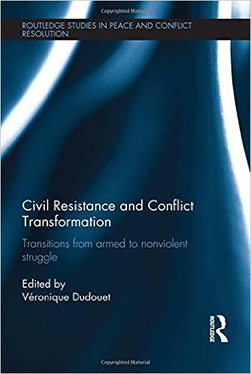
The Power of Staying Put: Nonviolent Resistance Against Armed Groups in Colombia
ICNC Monograph
2015
Free Download: English | Spanish
Purchase a Print Copy
Purchase an e-book (Nook | Kindle)
Abstract: Confronted with civil war, local civilians typically either collaborate with the strongest actor in town or flee the area. Yet civilians are not stuck with these choices. Collectively defying armed groups by engaging in organized nonviolent forms of noncooperation, self-organization and disruption is another option. This monograph explores this option through sustained and organized civil resistance led by ordinary peasants against state and non-state repressive actors in Colombia’s longstanding civil war: the case of the Peace Community of San José de Apartadó.
- Read Masullo’s article “Villagers stand up for peace in Colombia’s civil war.”
- Read “Campesinos colombianos que defienden la paz” (en español).

The Tibetan Nonviolent Struggle: A Strategic and Historical Analysis
ICNC Monograph
2015
Free Download: English | Tibetan
Purchase a Print Copy
Purchase an e-book (Nook | Kindle)
Abstract: Contrary to a perception—fueled by Chinese propaganda during the 2008 Tibetan uprising—that the Tibetan struggle is heading toward extremism, this study shows that the movement has since the 1950s moved toward a tighter embrace of nonviolent resistance. The study traces this evolution, analyzing the central themes, purposes, challenges, strategies, tactics and impacts of three major Tibetan uprisings over the past six decades. Tibetans are now waging a quiet, slow-building nonviolent movement, centered on strengthening the Tibetan national and cultural fabric via what the author refers to as transformative resistance. This is happening in an immensely repressive political environment, which shows that there is a way to mobilize people power against even one of the most ruthless regimes in the world.

The Paradox of Repression and Nonviolent Movements
Syracuse University Press, 2018 (research completed 2016-2017)
Abstract: The Paradox of Repression and Nonviolent Movements brings scholars and activists together to address multiple dimensions and significant cases of this phenomenon, including the relational nature of nonviolent struggle and the cultural terrain on which it takes place, the psychological costs for agents of repression, and the importance of participation, creativity, and overcoming fear, whether in the streets or online.

Civilian Opinion & Nonviolent Resistance: Survey Evidence from Mexico
International Center for Nonviolent Conflict
2015
Abstract: The study of why individuals utilize nonviolent resistance methods such as strikes, protests, marches, boycotts, and blockades to organize against abusive practices by states and non-state actors has made important progress and gained considerable attention over the last several years. However, a majority of this research has focused on nonviolent campaigns against authoritarian regimes, or other major maximalist movements. More recently, research has shifted attention to also assess how localized civilian efforts can combat the oppressive forces in their own communities, such as local corruption and violence, via nonviolent methods. Today, critical questions remain as to why individuals choose nonviolent resistance over violent resistance, and in what ways organizers might be able to shift this choice towards alternatives to violence. Furthermore, previous literature has been limited in its ability to address questions on violent versus nonviolent mobilization in the context of armed conflict. Do civilians prefer one method of resistance to another? Do civilians view either form of collective action as effective within a violent setting? This survey was designed to address these questions.
The survey was conducted in Mexico in February 2014. The survey data are from a national sample, with an oversample near regions containing local, civilian self-defense forces. The instrument was created to enable researchers and practitioners to be better equipped to understand the conditions under which civilians view nonviolent versus violent conflict as more effective for addressing challenges related to the violence they face, as well as those individual level traits associated with preferences for these different methods. Finally, the over-sample is constructed to measure whether opinion towards resistance is significantly different near contested regions containing local, armed, and civilian self- defense forces.”
This report provides a brief overview of key findings, a summary of other relevant variables from the survey, and the methodological process of the survey design.
Completed & Published Research: 2012-2014
Curtailing Corruption: People Power for Accountability and Justice
Lynne Rienner Publishers
2014
Free Download: English | Pashto
Purchase a Print Copy
Purchase an e-book (Nook)
Abstract: How do citizens counter corruption and exact accountability from power holders? What strategic value does people power bring to the anticorruption struggle? Can bottom-up, citizen-based strategies complement and reinforce top-down anticorruption efforts? Addressing these questions — and demonstrating the critical role of grassroots efforts in the anticorruption/accountability equation — the book explores how millions of people around the world have refused to be victims of corruption and become instead the protagonists of successful nonviolent civic movements to gain accountability and promote positive political, social, and economic change.
Website: curtailingcorruption.org
Free Download (individual chapters below):
- Chapter 1 — Corruption, People, and Power
- Chapter 2 — Approaches to Curbing Corruption
- Chapter 3 — Blacklisting Corrupt Candidates: Korea
- Chapter 4 — Digital Resistance for Clean Politicians: Brazil
- Chapter 5 — Citizens Protect an Anticorruption Commission: Indonesia
- Chapter 6 — Nonviolent Resistance Against the Mafia: Italy
- Chapter 7 — A Citizen Pillar Against Corruption: India
- Chapter 8 — Community Monitoring for Postwar Transformation: Afghanistan
- Chapter 9 — Curbing Police Corruption Through Engagement and Disruption: Uganda
- Chapter 10 — Highlights from Five Cases: Bosnia-Herzegovina, Egypt, Kenya, Mexico, Turkey
- Chapter 11 — What We Have Learned
- Chapter 12 — The International Dimension

Beyond Repression and Support: A Model to Understand the Nuances of Responses to Civil Resistance Campaigns (later published under the title Responses to Nonviolent Campaigns: Beyond Repression or Support)
Irene Publishing
2014
Abstract: How do authorities and so-called third parties at home and abroad respond to actions and campaigns led by civil resistance movements? This guiding question sets the stage for exploring the complex power dynamics of civil resistance campaigns. Through examples from civil resistance campaigns against occupation and dictatorship in Norway, Argentina, Serbia, Palestine and Egypt over the past 8 decades, this monograph introduces a model of five different strategies that oppressive governments use in responding to civil resistance campaigns. They include: validation (actively supporting or acknowledging a movement’s leaders or actions); pacification (placating or attempting to co-opt a movement); discredit or attacks (enforcing sanctions, intimidating activists through threats or violence, and/or falsely accusing or verbally attacking the movement); passivity (ignoring or simply expressing disapproval); and reframing what the issue is about in a constant battle over who will define what is true, right and just. This model improves understanding of the nuanced reactions that go beyond outright support and open repression, which is valuable both to the movements themselves and observers.

Recovering Nonviolent History: Civil Resistance in Liberation Struggles
Lynne Rienner Publishers
2013
Free Download: English | Russian | Farsi
Purchase a Print Copy
Abstract: The book brings to light the little-known, but powerful roles that civil resistance has played in national liberation struggles throughout history. Ranging from the American Revolution to Kosovo in the 1990s, from Egypt under colonial rule to present-day West Papua and Palestine, the authors of Recovering Nonviolent History consider several key questions: What kinds of civilian-based nonviolent strategy and tactics have been used in liberation struggles? What accounts for their successes and failures? Not least, how did nonviolent resistance influence national identities and socioeconomic and political institutions both prior to and after liberation, and why has this history been so often ignored? The story that emerges is a compelling one of the agency of thousands and even millions of ordinary people as they used nonviolent force in the course of struggles against foreign subjugation.
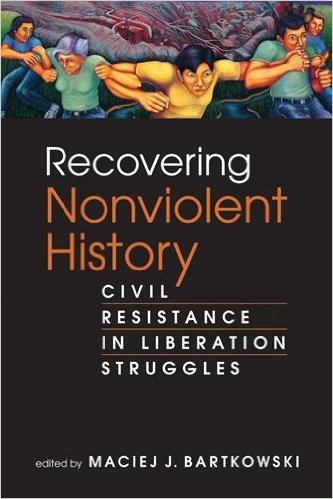
A Force Multiplier in Civil Resistance
2013-2014
Abstract: This study seeks a way of better understanding the rapid growth that sometimes occurs in the challenges mounted by civil resistance movements in pursuit of regime change. It identifies and problematizes what we call a force multiplier mechanism in which the astute tactical choices by a movement enhance popular participation in its activities while an increase in participation promotes further expansion of tactics. We consider three successful nonviolent movements and campaigns that occurred in different places at different times to illustrate the mechanism at work: Polish Solidarity, a boycott of businesses by anti-apartheid resisters in the South African city of Port Elizabeth in the mid- 1980s, and the Egyptian resistance that brought about President Hosni Mubarak’s resignation in 2011. The analysis does not offer a generalizable finding about the presence or absence of a force multiplier effect in other successful or failed campaigns or movements. Instead, the goal is to offer a unique conceptual perspective on the interactions between nonviolent tactics and participation that we observed in the selected case studies and so to stimulate further research on the idea of a force multiplier.
Civil Resistance and Democratization in Benin
2013
Abstract: This research focuses on the case of Benin 1989-1990. This is a unique case characterized by higher levels of violent repression and an authoritarian regime pre-revolution. The research’s aim is to make a long-time assessment of the impact of the unarmed revolution. It will include an introduction to the post-colonial history of Benin, ending with the analysis of tensions brought up to the surface between 1989 and 1990. After a summary of the processes of civil resistance up to the negotiations in the “National Assembly process” the focus will be on how the state bureaucracy, civil society organizations, media, trade unions, economical actors, educational institutions, health care, situation of minorities have changed during 20 years since the peaceful transition.
The Role of Civil Resistance in Peacebuilding: the Cases of Guatemala and Colombia
2014
Abstract: This analysis explores the logics of civil resistance within the context of peacebuilding, including within formal peace processes between elite armed actors and within informal political mobilizations wielded by non-state actors oriented towards transforming patterns of armed conflict and political violence. The research presents two case studies from the Latin American region, Guatemala and Colombia, where civil resistance has played a key role in peacebuilding. Research is situated at the interstices of the disciplines of peace studies, international relations and civil resistance studies, and aims to position critical peace studies and civil resistance scholarship in dialogue with each other, an undertaking broadly lacking in academic scholarship. The study analyses the impact of civil resistance on peacebuilding. More specifically, research elucidates the possible tensions and potential complementarities between centralized, formal peace-making carried out by the state and armed actors – understood within the liberal peace paradigm – and multi-level instances of civil resistance that aim to shape peacebuilding. The case studies contemplate whether peacebuilding is ultimately more successful in instances where civil resistance strategies have been employed. In this regard, the central question addressed is whether the generation of conditions to guarantee a more secure and durable post-conflict – that precludes the return to armed conflict and violent hostilities – is less improbable when civil resistance at local and national level shapes the peacebuilding process and the agenda that frames it.
The Role of Nonviolent Social Movements in Peacebuilding and Democratization in Fragile and Conflict-Affected States
2012
Abstract: The study’s main goal is to open up the discussion about the role and impact of nonviolent movements in a conflict-driven environment. In that sense, the paper does not provide a definitive analysis on how local societies organize themselves to address the problems associated with post-conflict situation or violent non-state actors or how we should study these phenomena but rather offer some interesting points of departure for further discussion and elaboration involving us as well as our academic advisors and collaborators.
Fragile countries and those emerging from conflict face a range of challenges in moving from ‘official’ peace to durable peace and democracy. Formal peace agreements or war-victories may not be felt or acknowledged across the entire territory of a country, and in some parts, violence may continue unabated. Many states also witness, after the formal end of hostilities, varying degrees of socially and politically-motivated violence. War-related legacies, such as the proliferation of small arms and light weapons, mobilized and aggrieved political groups, displaced and differentiated populations, weak or captured political institutions, and turbulent transitions leave lasting vulnerability to the recurrence of conflict. In addition, rapid political transitions, economic crises, external shocks from the global or regional context, and troubled electoral processes are all commonly identified as pivotal factors in the re-emergence of conflict.
The magnitude of the challenges, however, by no means spells an inevitable return to violence conflict. There are a range of conflict drivers, and other factors and phenomena that are commonly present in the post-conflict period, which, if addressed can considerably reduce the likelihood that a state will experience significant violent conflict. This discussion paper presents an overview of a number of these factors and issues, which have typically continued to contribute to fragility and a propensity for the occurrence and spread of violent conflict. A common theme in all of these is the need, and the opportunity, for transforming the actions of civil society actors and movements – whatever their motivations- into non-violent methods for seeking change. The paper separates these needs and opportunities into three broad sets of challenges confronting states emerging from violent conflict, and looks at how civic movements can help address these specific concerns associated with fragile and conflict-effected states.
Nonviolent Youth Movements in Post-Communist Hybrid Societies
2012
Abstract: ICNC sponsored a one-day research workshop to improve the quality of a book-length manuscript and publicize the results of the findings. This workshop came at a critical point in the research process because it allowed the author to obtain constructive criticism from established scholars in the field prior to the manuscript’s submission for rigorous peer review and, thus, facilitate the dissemination of her research findings to a wider audience. The proposed study fit in well with ICNC’s research agenda and its mission to expand public understanding of the principles of nonviolent conflict. The workshop consisted of several panels discussing the theoretical underpinnings of the study and examining cases of both successful and unsuccessful youth mobilization. The full-day event was held at Fordham University’s Leitner Center for International Law and Justice in New York and was open to the public to raise public awareness of nonviolent resistance in the post-communist region and stimulate further interest in the topic.
Completed & Published Research: 2009-2011
Why Civil Resistance Works: The Strategic Logic of Nonviolent Conflict
Columbia University Press
2011
Purchase a Print Copy: English | Pashto
Purchase an e-book (Kindle)
Abstract: Combining statistical analysis with case studies of specific countries and territories, Erica Chenoweth and Maria J. Stephan detail factors enabling nonviolent resistance campaigns to succeed and, sometimes, fail. They find such campaigns present fewer obstacles to moral and physical involvement and commitment, and higher levels of participation contribute to enhanced resilience, greater opportunities for tactical innovation and civic disruption (and therefore less incentive for a regime to maintain its status quo), and shifts in loyalty among opponents’ erstwhile supporters, including members of the military establishment. Chenoweth and Stephan conclude that successful nonviolent resistance ushers in more durable and internally peaceful democracies, which are less likely to regress into civil war. Presenting a rich, evidentiary argument, they originally and systematically compare violent and nonviolent outcomes in different historical periods and geographical contexts, debunking the myth that violence occurs because of structural and environmental factors and that it is necessary to achieve certain political goals. Instead, the authors discover, violent insurgency is rarely justifiable on strategic grounds.

Defeating Authoritarian Leaders in Post-communist Countries
Cambridge University PressJune 2011
Purchase a Print Copy
Purchase an e-book (Nook | Kindle)
Abstract: From 1998 to 2005, six elections took place in postcommunist Europe and Eurasia that had the surprising outcome of empowering the opposition and defeating authoritarian incumbents or their designated successors. Valerie J. Bunce and Sharon L. Wolchik compare these unexpected electoral breakthroughs – with one another and with elections that had the more typical result of maintaining authoritarian rule. They draw three conclusions. First, the opposition was victorious because of the hard and creative work of a transnational network composed of local opposition and civil society groups, members of the international democracy assistance community, and graduates of successful electoral challenges to authoritarian rule in other countries. Second, the remarkable run of these upset elections reflected the ability of this network to diffuse an ensemble of innovative electoral strategies across state boundaries. Finally, elections can serve as a powerful mechanism for democratic change. This is especially the case when civil society is strong, the transfer of political power is through constitutional means, and opposition leaders win with small mandates.

Struggling for Recognition: The Psychological Impetus for Democratic Progress
Bloomsbury Publishing
2012
Abstract: Struggling for Recognition posits that the drive for personal recognition is a prime motivation in struggles leading to democratic progress. It underscores a fundamental aspect of human nature, that is, the drive for positive self-esteem and status and the aversion of negative self-esteem and subordination. This pursuit of recognition becomes the impetus for action and it functions in various ways in contentious politics, such as overcoming fear and overriding rational calculations that may hinder collective action. The book examines the mechanisms by which this disposition is triggered and converted into political pressures that eventually lead to democratic reforms.

Civilian Jihad: Nonviolent Struggle, Democratization, and Governance in the Middle East
Palgrave Macmillan
2009
Free Download: English | Pashto
Abstract: The Middle East, a region infamous for political violence and a democratic deficit, boasts a rich but little-known history of nonviolent civilian-led struggles for rights and freedoms. Ordinary Egyptians, Palestinians, Turks, Israelis, Iranians, Kuwaitis and other Middle Easterners have, over the past century, used “weapons” including boycotts, strikes, demonstrations, sit-ins, and other methods of civil disobedience and noncooperation to courageously challenge entrenched power and to advance democratic self-rule. This book challenges the oft-heard claim that nonviolent resistance “can’t work” in the Middle East by chronicling some of the most significant nonviolent campaigns against colonialism, foreign occupation, authoritarianism, and structural injustice in the region. Other chapters examine the role of strategy, political humor, religion, Islamist movements, and external actors in advancing and impeding democratization and good governance. This volume, which includes scholarly and activist perspectives, will be of particular interest to academics, policymakers, journalists, and local civic leaders interested in the Middle East, nonviolent action, social movements, democratization, and war and peace studies – as well as educated general readers interested in understanding present convulsions in the Middle East.

Civil Resistance and Power Politics: The Experience of Non-violent Action from Gandhi to the Present
Oxford University Press2009
Purchase a Print Copy
Purchase an e-book (Nook | Kindle)
Abstract: This widely-praised book identified peaceful struggle as a key phenomenon in international politics a year before the revolutions in Tunisia and Egypt confirmed its central argument. Civil resistance — nonviolent action against such challenges as dictatorial rule, racial discrimination and foreign military occupation — is a significant but inadequately understood feature of world politics. Especially through the peaceful revolutions of 1989, and the developments in the Arab world since December 2010, it has helped to shape the world we live in. Civil Resistance and Power Politics covers most of the leading cases, including the actions master-minded by Gandhi, the US civil rights struggle in the 1960s, the Islamic revolution in Iran in 1979, the ‘people power’ revolt in the Philippines in the 1980s, the campaigns against apartheid in South Africa, the various movements contributing to the collapse of the Soviet Bloc in 1989-91, and, in this century, the ‘colour revolutions’ in Georgia and Ukraine. The chapters, written by leading experts, are richly descriptive and analytically rigorous.

Completed Research: 2005-2008
Why Civil Resistance Works: The Strategic Logic of Nonviolent Conflict (Article)
International Security, Vol. 33, No. 1, pp. 7–44
Summer 2008
Free Download: English | Chinese | Spanish | Turkish
Abstract: Implicit in recent scholarly debates about the efficacy of methods of warfare is the assumption that the most effective means of waging political struggle entails violence. Among political scientists, the prevailing view is that opposition movements select violent methods because such means are more effective than nonviolent strategies at achieving policy goals. Despite these assumptions, from 2000 to 2006 organized civilian populations successfully employed nonviolent methods including boycotts, strikes, protests, and organized noncooperation to challenge entrenched power and exact political concessions in Serbia (2000), Madagascar (2002), Georgia (2003) and Ukraine (2004–05), Lebanon (2005), and Nepal (2006).3 The success of these nonviolent campaigns — especially in light of the enduring violent insurgencies occurring in some of the same countries — begs systematic investigation. The central contention of this study is that nonviolent resistance methods are likely to be more successful than violent methods in achieving strategic objectives. The researchers compared the outcomes of 323 nonviolent and violent resistance campaigns from 1900 to 2006, and compared these large-n findings with comparative case studies of nonviolent campaigns in Southeast Asia.

A Diplomat’s Handbook for Democracy Development Support, Second Edition
Published by The Centre for International Governance Innovation, in partnership with the Council for a Community of Democracies
2010
Abstract: Responding to requests from civil society and governments, diplomats make important contributions to democratic development. Their work is largely unknown. Outdated stereotypes of this profession persist. The Diplomat’s Handbook begins to tell the diplomat’s story through case studies of practical measures diplomats from many democratic countries have taken across the globe. The Handbook recognizes that democracy cannot be exported or imported. It must be developed by the citizens of the country concerned. There is no one formula for success. But outside assistance is often requested, and there is a dearth of professional material for training and guiding our diplomats in deciding how they can appropriately respond. Civil society as well as governments can benefit from the Handbook, gaining a better understanding of what they can request from diplomats, who in today’s public diplomacy represent their own civil society as well.
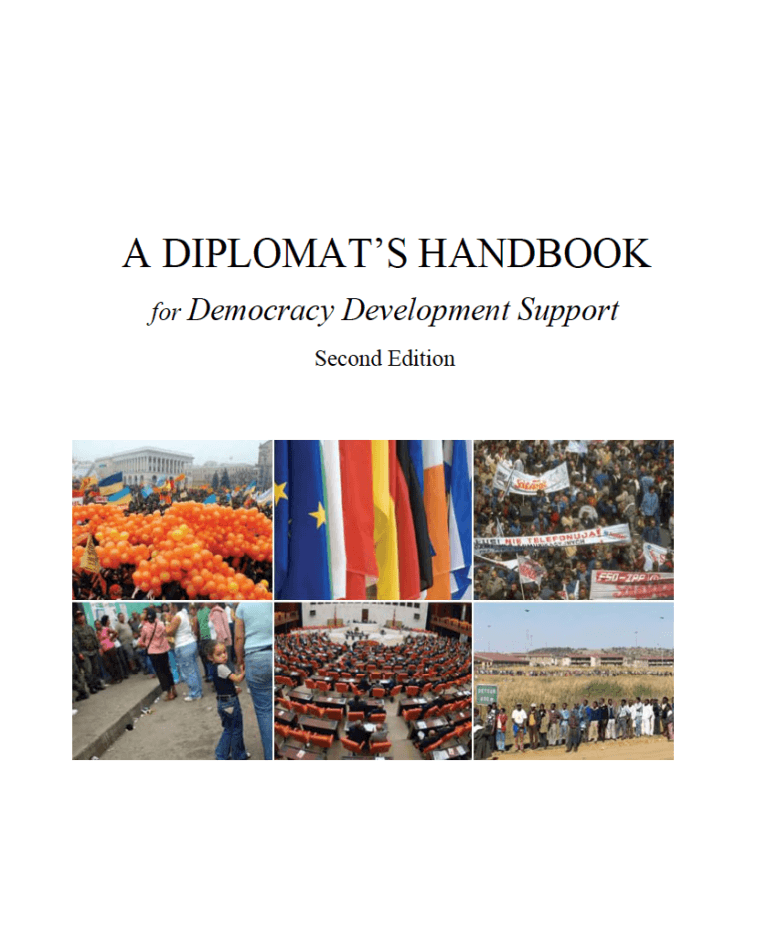
Fighting for Statehood: The Role of Civilian-Based Resistance in the East Timorese, Palestinian, and Kosovo Albanian Self-Determination Movements
Abstract: National liberation movements have often resorted to guerilla warfare or terrorism in their struggles against colonial powers and foreign occupiers. During the 1960s and 1970s, violent revolutionaries captured media headlines, although the tactics they used produced more civilian casualties and material destruction than meaningful political change. Methods of violent insurgency became less successful in the latter half of the twentieth century for a number of reasons, including state expansion and improved counterinsurgency strategies, which shifted the balance of power away from armed insurgents and toward states. Nevertheless, conflicts between national groups and states for control over territory did not entirely fade away as the period of decolonization ended.

How Freedom is Won: From Civic Resistance to Durable Democracy
Washington, DC: Freedom House
2005
Abstract: The study, How Freedom is Won: From Civic Struggle to Durable Democracy focuses on 67 countries where dictatorships have fallen since 1972. It draws on over 30 years of Freedom House data analyzing the state of global freedom and is the most comprehensive examination of political transitions ever conducted. The report’s central conclusion is that how a transition from authoritarianism occurs and the forces that drive the transition have significant impact on the success or failure of democratic reform. In large measure, the study finds that transitions generated by nonviolent civic coalitions lead to far better results for freedom than top-down transitions initiated by elites. The study finds that “people power” is a frequent phenomenon, and civic coalitions are a major presence in most transitions. In 50 of the 67 transitions, or over 70 percent of countries where authoritarian systems fell, nonviolent civic resistance was a strong influence. Civic resistance employs such tactics as mass protests, boycotts, blockades, strikes, and civil disobedience to challenge the legitimacy of and erode support for authoritarian rulers. How Freedom is Won is available on the Freedom House website.
